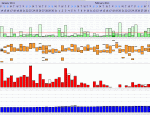Robysue the mathematician can explain the numbers!
The odd thing about the way the data is presented in this sleep study is that the event counts are for the total events for the entire night, some indices are computed for the whole night, some indices are computed for the diagnostic (pre-CPAP) part of the night, and some indices are computed for the treated (with CPAP) part of the night.
Alathea_Squared got right at 5 hours of sleep total. Of that, 122.5 minutes = 2.04 hours were in the diagnostic part of the test and 175.5 minutes = 2.93 hours were in the treated part of the test.
The respiratory event counts for the
entire night were:
42 RERAs
70 Hypopneas with desaturation.
My guess is that the hypops with desat were probably scored under the AASM Recommended Standard; in that case they required at least a 4% drop in O2, but did not
require an arousal. However, if a hypop has both an arousal AND at least a 4% drop in O2, it counts as a hypop with desat, not a hypop with arousal.
Now, the
overall AHI = 70/5 = 14.1 and the
overall RDI = (70+42)/5 = 112/5 = 22.4 (There's some roundoff here because the total sleep time is actually just a wee bit under 5 hours.)
But those mysterious and apparently implausible AHI figures listed in the Pre-Treatment column at the end of the table are based the 122.5 minutes = 2.04 hours of Pre-Treatment sleep. Of these 2.04 hours of sleep, 29% was supine. Hence the Pre-Treatment supine sleep totaled .29*2.04 = 0.59 hours. And that means 2.04-.59 = 1.45 hours of PRE-treatment sleep was non-supine. We can now apply a bit of old fashioned algebra to determine how many of the events happened in the Pre-Treatment part of the study and how many happened Post Treatment. To summarize the sleep times in the PRE-Treatment part of the test:
- 2.04 hours of total PRE-treatment sleep
- 1.45 hours of non-supine PRE-treatment sleep
- 0.59 hours of supine PRE-treatment sleep
Easy part first: Since the POST treatment AHI = 0.0, that means all 70 of the hypopneas with desat happened during the PRE-treatment part of the test. That means the PRE-treatment AHI's are calculated as follows:
- Pre-treatment AHI = 70/2.04 = 34.3
- Pre-treatment supine AHI = 93 means (# hypops supine)/.59 = 93, which implies (# hypops supine) = 93 * .59 = 55. In other words, of the 70 hypops recorded during the study, 55 of them happened during the 36 minutes of supine sleep in the PRE-treatment part of the test.
- Pre-treatment non-supine AHI = 10 means (# hypops non-supine)/1.45, which implies (# hypops nonsupine) = 10 * 1.45 = 15. In other words, of the 70 hypops recorded during the study, 15 of them happened during the 1.45 hours of non-supine sleep in the pre-Treatment part of the test.
The RDI numbers, which include the RERAs can be found by first determining the number of RERAs that occurred during the Post-treatment part of the test:
Post-Treatment RDI = 3.1 AND post-treatment AHI = 0.0 together imply that all the events in the numerator of the post-treatment RDI are RERAs. So we have: (# post-treatment RERAs)/2.93 = 3.1, which implies (# post-treatment RERAs) = 3.1 * 2.93 = 9 post-Treatment RERAs.
And since 9 of the 42 RERAs occurred in the post-Treatment part of the test, that means 42-9 = 33 RERAs occurred during the PRE-treatment part of the test. So the Pre-treatment RDI is computed as follows:
Pre-treatment RDI = (70 hypops + 33 RERAs)/2.04 = 103/2.04 = 50.5
Now the upshot of all this arithmetic? Here are the figures you want to think about as your diagnostic figures:
- 2.04 hours of sleep, with 0.59 hours supine and 0.0 hours REM
- 70 hypopneas with desat (most likely requiring at least a 4% drop in O2 levels); overall AHI = 70/2.04 = 34.3
- 55 hypops with desat while sleeping on your back; supine AHI = 55/0.59 = 93
- 15 hypops with desat while NOT sleeping on your back; nonsupine AHI = 10/1.45 = 10
- No REM means No AHI index, with is reported as REM AHI = 0.0
- NREM sleep time = 2.04, so NREM AHI = Overall AHI = 34.3, but it is rounded to 33
- 33 RERAs occurred during the pre-treatment period; hence pre-treatment RDI = (33+70)/2.04 = 50.4
Your diagnosis of severe sleep apnea was based on that Pre-Treatment AHI = 34.3. The fact that the events are all hypopneas with desaturation instead of apneas is not important in making the diagnosis. The fact that your RDI is much higher probably does indicate that you've also got some UARS going on, but keep in mind that many sleep docs view UARS and OSA as a continuum of sleep disordered breathing. In other words, think of the RERAs as "baby hypops" that may very well turn into real hypops (and those real hypops may turn into apneas) if you left your OSA untreated for a long enough period of time.
And, as pugsy points out, there appears to be a very significant positional component to your (untreated) apnea: It is far, far worse on your back than not on your back. But even the nonsupine AHI = 10 puts you in the middle of the mild OSA range.

















